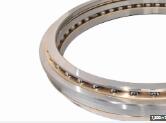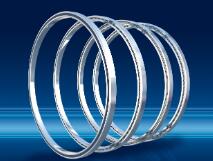4 Benefits of Thin Section Bearings in Manufacturing
Discover the advantages of using thin-section bearings in manufacturing.
Read on to learn how these specialized bearings can benefit your production process.
As a manufacturer, you're always looking for ways to optimize your production process and improve efficiency.
One area often overlooked is the type of bearings used in your machinery.
Thin section bearings offer several advantages over traditional bearings, making them a smart choice for many manufacturing applications.
1.Space Saving
2.Reduced Friction
3.High Precision
4.Increased Speed
This article will explore four key benefits of using thin-section bearings in manufacturing.
From reducing friction and increasing speed to saving space and enhancing precision, there are several reasons why these specialized bearings can be a game-changer for your production process.
What is Thin Section Bearings

Thin Section Bearings are a bearing specifically designed to provide radial load capacity in confined spaces or applications with limited radial space.
They are characterized by their thin cross-section, usually between 1/4" and 3/4" in thickness, and have relatively low axial height requirements compared to standard bearings.
Thin section bearings consist of two rings, an inner ring with grooves cut into the inner race and an outer ring (or cage) with rollers that fit into these grooves.
The rollers and raceway create a rolling contact, which allows the bearing to carry both radial and axial loads simultaneously.
Thin section bearings are most commonly used for applications where space is limited, such as in instrumentation systems, robotics equipment, or medical devices.
In addition to their thin profile and low axial height, they offer several other advantages compared to traditional ball or roller bearings.
These include higher accuracy, lower noise levels, and improved wear resistance due to the improved surface finish of the raceways.
Thin section bearings can also be manufactured with small bores or larger inside diameters than traditional ball or roller bearings, allowing them to be used in many different applications.
In terms of design considerations, thin section bearings must consider both static and dynamic loads when specified.
Static loads refer to forces that remain constant throughout the operation,
while dynamic loads refer to those which vary during the process due to accelerations or torque changes.
Due to their thin profile, thin-section bearings are generally more sensitive in dynamic loading than standard ball or roller bearing designs,
as they cannot withstand high accelerations for long periods without sustaining damage.
As such, it is essential for engineers designing components containing thin section bearing arrangements to consider both static and dynamic loading
when selecting their suitable design parameters for their application - this ensures that the correct bearing size is chosen for its intended purpose
while ensuring that it will not sustain damage from any unforeseen dynamic forces it may encounter during its working life.
The construction materials used when producing thin section bearings also play an essential role in achieving optimal performance from them;
softer materials such as carbon steel tend to give better performance against static loads but lack the durability required for dynamic loading conditions,
whereas more complex materials such as stainless steel offer better protection against dynamic loading but reduce accuracy levels due to their lower elasticity properties.
The choice between these two depends on whether static or dynamic loading dominates the application - if static loading dominates, then softer materials should be chosen.
In contrast, if dynamic loading dominates, more rigid materials should be considered.
Benefits of Thin Section Bearings in Manufacturing

Space Saving
Thin-section bearings are designed to have a much smaller cross-section than traditional ball bearings, allowing them to take up less space while still providing the necessary load capacity.
This space-saving design is particularly beneficial in manufacturing applications where space is limited or compact equipment is required.
For example, in medical devices such as ultrasound machines and X-ray scanners, thin section bearings enable smaller and more portable equipment to be developed without sacrificing performance.
Compared to traditional ball bearings, thin-section can operate with a smaller cross-section due to the use of unique materials and manufacturing processes that allow for increased strength and durability despite the smaller size.
This makes them an attractive option for manufacturers looking to save space and reduce the weight and size of their products.
Reduced Friction
In bearings, friction is the force that opposes the motion and causes wear and tear on the components.
Thin section bearings are designed to reduce friction using materials and lubricants that minimize frictional losses.
This increases efficiency and reduces wear and tear on the bearings and the components they support.
Reduced friction also translates to improved performance and energy savings, making thin section bearings an attractive option for manufacturers looking to optimize the efficiency of their equipment.
Compared to traditional ball bearings, thin-section bearings significantly reduce frictional losses, particularly at higher speeds and loads.
This makes them an ideal choice for high-performance and efficiency applications.
High Precision
Precision in bearings refers to the degree of accuracy and consistency in the manufacturing and operation of the bearing.
Thin section bearings are designed with high precision, allowing them to deliver improved control, accuracy, and performance.
High precision advantages include increased positioning and motion control accuracy, improved stability and repeatability, and reduced vibration and noise.
This makes thin section bearings an attractive option for applications that require high precision and reliability, such as robotics, automation, and aerospace.
Compared to traditional ball bearings, thin-section bearings offer higher precision due to their unique design and manufacturing processes.
This makes them an ideal choice for applications requiring high accuracy and control levels.
Increased Speed
Speed in bearings refers to the maximum rotational speed at which the bearing can operate without causing damage or failure.
Thin section bearings are designed to operate at higher speeds than traditional ball bearings,
making them an ideal choice for applications that require faster cycle times and increased productivity.
The advantages of increased speed include faster processing times, reduced cycle times, and increased productivity.
This makes thin section bearings an attractive option for applications such as packaging equipment, printing presses, and other high-speed machinery.
Compared to traditional ball bearings, thin-section can operate at higher speeds due to their lighter weight and reduced frictional losses.
This makes them an ideal choice for high-speed operation and efficiency applications.
Conclusion

If you're looking for ways to improve your manufacturing process, consider the benefits of thin-section bearings.
These specialized bearings can help you optimize your production process and achieve better results by reducing friction, increasing speed, saving space, and enhancing precision.





